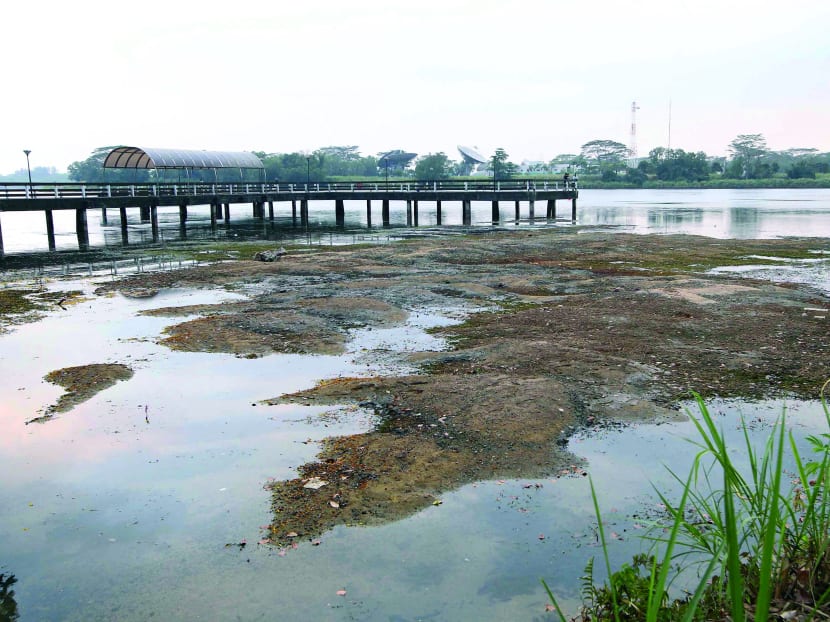Extreme weather, rising sea levels among environmental challenges
SINGAPORE – After the prolonged dry spell this year, a water-rationing exercise could be on the cards next year to educate the public on how to save water, said Environment and Water Resources Minister Vivian Balakrishnan in an exclusive interview with Channel NewsAsia.

Some areas around the Lower Seletar Reservoir dried up on March 4, 2014 due to the prolonged dry weather. TODAY file photo
SINGAPORE – After the prolonged dry spell this year, a water-rationing exercise could be on the cards next year to educate the public on how to save water, said Environment and Water Resources Minister Vivian Balakrishnan in an exclusive interview with Channel NewsAsia.
He said the dry spell and rising sea levels serve as a warning of extreme weather in the future, which Singapore needs to be prepared for.
In February, Singapore faced the its driest month in 145 years, which led to blistering weather, parched landscapes as well as an increase in the demand for water.
Dr Balakrishnan said Singapore saw through the period thanks to decades of investment in infrastructure, such as desalination plants, and in technology such as NEWater. Going forward, his ministry is reviewing its current infrastructure of reservoirs and storage capacities, and could roll out more desalination plants.
But water demand needs to be managed. “I’m still contemplating when or how we should embark on a public education campaign, perhaps with a water rationing exercise - not because we are desperately short but because we have to make the point that we do need to be prepared and if we do need to reduce water consumption, how does it affect our daily lives,” said Dr Balakrishnan.
“So that’s something we may need to think about next year and perhaps the best time to do that is precisely at the time when there isn’t a dry spell.”
From June 2015, large commercial water users will have to submit to PUB their plans to use water more efficiently. Dr Balakrishnan said once the companies and the authorities can get a sense of “what works and what does not”, the plan could be rolled out to smaller non-domestic consumers.
The dry spell also brought haze to the region earlier. Dr Balakrishnan said Singapore was spared the brunt of it because of several factors – from favourable wind direction to the Transboundary Haze Pollution Act. Under the Act, errant companies could be fined up to S$2 million should the haze hit “unhealthy levels”.
Turning to another perennial problem, dengue, Dr Balakrishnan warned that the virus could take on a new form. “After having two years of predominantly dengue type 1, we know from past experience, when there is a subsequent serotype switch in a year or two or even three years from now, there is the danger of another rebound epidemic, so dengue will keep us occupied,” he said
“We are also studying the possibility of using a special strain of mosquitoes with Wolbachia infection in order to try to reduce the population of mosquitoes. If we are convinced that it is safe, then it is possible that sometime next year, we can embark on field trials.”
Late this year, the government released the second Sustainable Singapore Blueprint, which charts the environmental vision for the next five years. It includes reducing the reliance on private transportation as well as improving Singapore’s recycling rate. Dr Balakrishnan said food recycling is a key focus going forward, as it currently stands at a lowly 13 per cent.
Globally, the international community is grappling with climate change. Sea levels are projected to rise between about 28cm and 98cm by 2100, which could prove to be catastrophic for countries with coastal, low-lying areas if they are not prepared. To guard against this, reclaimed land in Singapore has to be 2.25m above the highest recorded tide level. Previously, the minimum requirement was 1.25m.
This will affect the land where Changi Airport’s new Terminal 5 will be located. The terminal will be built on an existing plot of reclaimed land measuring some 1,000 hectares. Channel NewsAsia understands parts of the land do not meet the 2.25m criteria. The Ministry of Transport says that will have to be topped up.
“The airport will be safe enough from future sea level rise, but this doesn’t take into account other factors,” said Dr Wong Poh Poh, coordinating lead author of the UN Intergovernmental Panel on Climate Change. “What if there were to be an extreme high tide that coincides with storm surges? Anything can happen. You must always remember that tsunamis can happen in this part of the world.”
Dr Wong said solutions can be found in the eco-system. Coral reefs have been found to reduce energy produced by waves by up to 80 per cent and mangroves can be grown to protect shorelines. Dr Wong said ideal locations for mangroves can be in the waters around Pulau Ubin, Pulau Tekong and Singapore’s southern islands. CHANNEL NEWSASIA






